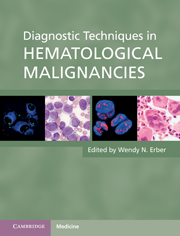Book contents
- Frontmatter
- Contents
- List of Contributors
- Preface
- Part 1 Diagnostic techniques
- Part 2 Hematological malignancies
- 6 The integrated approach to the diagnosis of hematological malignancies
- 7 Acute lymphoblastic leukemia
- 8 Acute myeloid leukemia
- 9 Mature B-cell leukemias
- 10 Mature T-cell and natural-killer cell leukemias
- 11 Lymphoma
- 12 Plasma cell neoplasms
- 13 Chronic myeloid leukemia
- 14 Myeloproliferative neoplasms
- 15 Myelodysplastic syndromes and myelodysplastic/myeloproliferative neoplasms
- Index
- References
6 - The integrated approach to the diagnosis of hematological malignancies
from Part 2 - Hematological malignancies
Published online by Cambridge University Press: 06 December 2010
- Frontmatter
- Contents
- List of Contributors
- Preface
- Part 1 Diagnostic techniques
- Part 2 Hematological malignancies
- 6 The integrated approach to the diagnosis of hematological malignancies
- 7 Acute lymphoblastic leukemia
- 8 Acute myeloid leukemia
- 9 Mature B-cell leukemias
- 10 Mature T-cell and natural-killer cell leukemias
- 11 Lymphoma
- 12 Plasma cell neoplasms
- 13 Chronic myeloid leukemia
- 14 Myeloproliferative neoplasms
- 15 Myelodysplastic syndromes and myelodysplastic/myeloproliferative neoplasms
- Index
- References
Summary
The preceding chapters have illustrated that the analysis of hematological malignancies utilizes a range of cellular and genetic techniques of increasing sophistication and sensitivity. These generate bio-information of greater complexity than ever before, thereby requiring extensive data interpretation and integration. Only when the results of all test parameters are viewed together can the data facilitate an accurate and timely diagnosis, give prognostic indices, and be useful for monitoring treatment and/or disease progression. This approach necessitates a centralized laboratory facility staffed with a multi-skilled medical and scientific workforce focused on hemato-oncology diagnostics. They must be capable of carrying out a wide repertoire of diagnostic investigations and have the ability to interpret the data. This integrated approach to hemato-oncology diagnostics has proven advantages for clinicians and their patients. These comprehensive diagnostic centers are now being established in a number of countries. This chapter describes the structure of and role for integrated hemato-oncology diagnostic services.
What is an integrated hemato-oncology diagnostic service?
An integrated hematological malignancy (or hemato-oncology) diagnostic service is a comprehensive diagnostic facility for the processing and analysis of pathology samples from patients with, or suspected of having, a hematological neoplasm (Figure 6.1). Multiple test modalities are completed on a single sample, the results integrated and interpreted within the clinical context, a single report generated, and the information communicated to the requesting clinician. The concept is of “one patient, one diagnosis, one report” and this is only achievable with a multi-disciplinary laboratory performing all the relevant and up-to-date investigations.
- Type
- Chapter
- Information
- Diagnostic Techniques in Hematological Malignancies , pp. 111 - 126Publisher: Cambridge University PressPrint publication year: 2010
References
- 1
- Cited by



